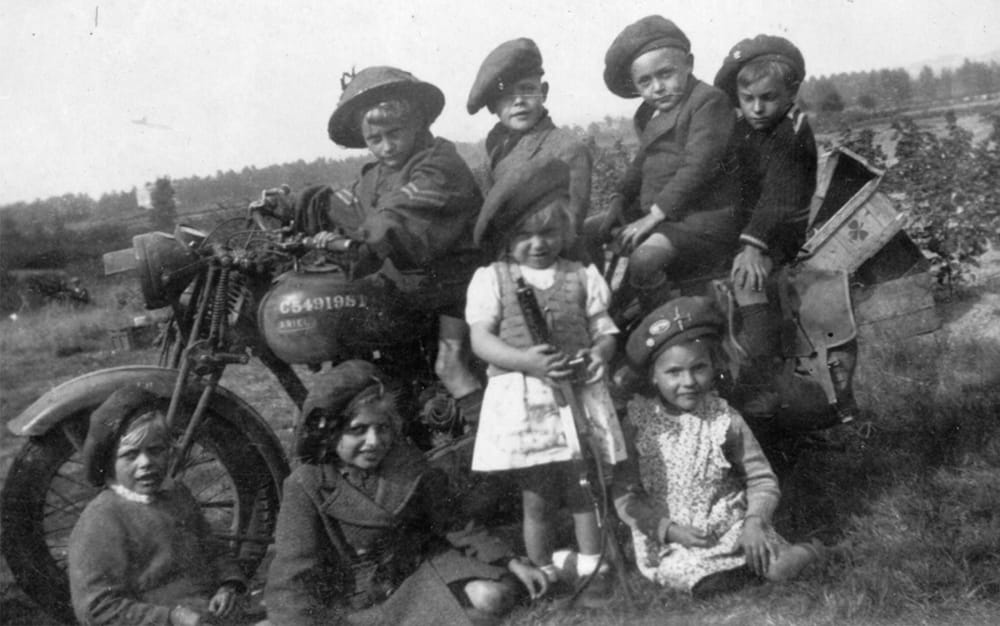Hi,
I have a 1938 BSA M23 frame number JM19 300 that appears to have been impressed and went to RAF Hullavington. First registered to there in 1942.
It currently has a M21 engine fitted which i cant quite work out what year it really is. I will describe it as i cant load pics.
On the drive side there is no visible breather, it is stamped JM21 288 (which would be 38) but has later 10 bolt barrel/head and on the timing side is stamped 39 and broard arrow below valve cover, along with MU10 stamp inside cover. The timing side is the 39 on M series later type with the outrigger support plate for cams and removable plug for magneto gear.
The JM on engine does not appear to have been re stamped
Can anyone maybe shed light on this engine??
THanks
Marcus
email (option): marcus@glassenbury.plus.com
If the breather is on the timing side, it sounds like post war crankcases to me. Email me the pictures if you want and I'll add them in this thread. Ron
email (option): ronpier@talk21.com
I went on an Air Training Corps summer camp to RAF Hullavington over 50 years ago...In those days the ATC squadrons got a rail warrant to travel and we were picked up at the station by RAF 3 tonners..It was a non operational camp by then as far as aircraft were concerned...From memory I think it was a parachute packing station among other things...There were plum trees growing around the camp, all you had to do was reach up... (though that wasn't allowed in theory)....Happy days indeed...Ian:relaxed:
email (option): ian@wright52.plus.com
Breather is on drive side out of main bearing housing. So mid height. I wonder if workshop fitted a JM drive side casing to KM right side casing. I will email pics later today. Thank you
email (option): Marcus@glassenbury.plus.com
That sounds more like it then Marcus. I guess it will all line up. With the benefit of the wider engine and extra main bearing. Not to mention the extra cooling for the barrel.:+1: Pictures would be good. Ron
email (option): ronpier@talk21.com
BSA had problems with the breathers I think...At various times they exited from the rear of the main bearing housing in the crank case, just below the barrel on the drive side and from the timing cover...The timing cover breather arrangements went through three different changes to reduce the amount of oil loss and there are two different versions of the internal breather flap valves...(and of course there's the timed breather on the late Gold Stars)...Not to mention the two different diameter vent pipes on SV and OHV engines...
The 'piece de resistance' had to be the late WB30, which had a breather in the crankcase, the timing cover and two additional 'non valved' breathers in the rocker covers!!....Ian
email (option): ian@wright52.plus.com
Is the JM the narrow frame and engine, if so shirley a wide engine wouldn't fit in??
Rob
email (option): robmiller11(a)yahoo.co.uk
It’s an interesting bike I think.
email (option): Marcus@glassenbury.plus.com
Rob
email (option): keithchandler@clistandchandler.co.uk
Have you checked the crank case half numbers on the engine plate boss at the front of the engine?...Ian
email (option): ian@wright52.plus.com
I have now seen the spacer where the front down tube meets bottom frame rails. I take a look at casing numbers but I am thinking they will not match.
email (option): Marcus@glassenbury.plus.com
That seems likely...It looks like you have the crank case halves from two different WD engines...
Unfortunately the correct engine you require, or parts off, aren't all that common, though not impossible to find....Virtually no internal parts from the timing side or the top half components are interchangeable between the two types....Ian
email (option): ian@wright52.plus.com
Actually not a bad combination to my mind. maintaining the character and engine number of a 1938 bike with the extra robustness and improvements of a later engine:+1: Ron
email (option): ronpier@talk21.com
There were no JM prefix 20 or 21 supplied to the War Office so it would perhaps be worhtwhile to ask the BSA OC or the VMCC where that engine went to.
The Inspection mark (is it 39 or 89 ?) will apply to the individual inspector rather than be a year indicator. Unlike many factories,where all the early-war engines were inspected, BSA seem to have only been subject to occasional controls. Does anyone else have a similar stamping ? These inspectors only seem to have stayed 6 months or so at each location. I can date early-war Nortons in this manner.
Inspector M89 stayed at the BSA factory in the (late) 1939 - (early) 1940 period. I have these examples in my Register:
KM20.1376, KC10.1779, WC10.552, WC10.583, WC10.720, WM20.11612.
The next one in my list is WM20.20576, with acceptance marking M^65.
More examples are always welcome! :grinning:
email (option): wd.register@gmail.com
So far as the bike is concerned I plan to keep it mostly as is ‘ex government’ trim. It appears to have been black since it’s wartime use except for the green tank panels which look to have been added later. I am quite happy with its current engine for now as it’s original engine JM23 159 is unlikely to be found or any JM23 engine for that matter. I may think about fitting a later B/M ohv engine one day.
email (option): Marcus@glassenbury.plus.com
KM20.1376, KC10.1779, WC10.552, WC10.583, WC10.720, WM20.11612.
The next one in my list is WM20.20576, with acceptance marking M^65.
More examples are always welcome! :grinning:
Any info ?
email (option): Marcus@glassenbury.plus.com
Any ideas what EDE May stand for?
email (option): Marcus@glassenbury.plus.com




